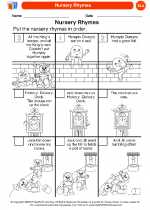Nursery Rhymes Study Guide
Nursery rhymes are traditional poems and songs for young children. They are a crucial part of early childhood education as they help in language development, rhythm, and memory skills. Here's a study guide to help you understand and enjoy nursery rhymes!
What are Nursery Rhymes?
Nursery rhymes are short, traditional poems and songs for children. They often have simple and catchy rhymes, rhythms, and repetitive patterns. They are usually passed down orally from generation to generation.
Benefits of Nursery Rhymes
- Language Development: Nursery rhymes help children learn new words and sentence structures.
- Rhythm and Rhyme: They introduce children to the rhythm and rhyme of language, which is important for early literacy skills.
- Memory Skills: The repetitive nature of nursery rhymes helps children with memory recall.
- Cultural Literacy: Many nursery rhymes have historical and cultural significance, offering insight into different cultures.
Popular Nursery Rhymes
Here are some popular nursery rhymes:
- Twinkle, Twinkle, Little Star
- Old MacDonald Had a Farm
- Humpty Dumpty
- Row, Row, Row Your Boat
- Itsy Bitsy Spider
Activities for Nursery Rhymes
Here are some activities to make nursery rhymes engaging:
- Acting out the Rhymes: Encourage children to act out the nursery rhymes through simple role-playing.
- Illustrating the Rhymes: Have children draw or paint scenes from the nursery rhymes to encourage creativity.
- Singing and Dancing: Sing along and create simple dance moves to go with the rhythm of the nursery rhymes.
- Writing their own Rhymes: Encourage children to create their own simple rhymes and share them with the class.
Understanding and enjoying nursery rhymes is an essential part of early childhood education. They provide a fun and interactive way for young children to learn language and literacy skills!
[Nursery Rhymes] Related Worksheets and Study Guides:
.◂English Language Arts Worksheets and Study Guides Kindergarten. Nursery Rhymes
The resources above cover the following skills:
Reading Standards: Foundational Skills
Phonological Awareness
Demonstrate understanding of spoken words, syllables, and sounds (phonemes). [RF.K.2]
Recognize and produce rhyming words. [RF.K.2a]


